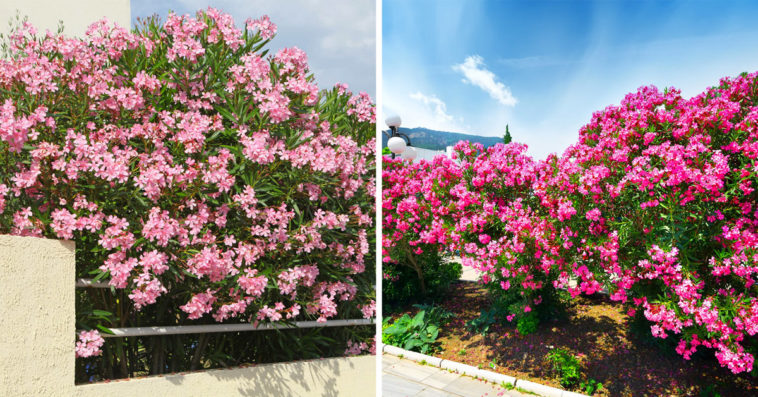Oleander or ‘Nerium oleander’ is a fast growing, very vigorous and low maintenance evergreen shrub. This plant with beautiful flowers is typical of Mediterranean vegetation and is widespread in southern Europe. It is often planted in the garden, but it is also possible to grow it in pots. Oleander produces beautiful, fragrant flowers throughout the summer. It is easy to find this plant in its natural state in the southern regions.
Laurier-rose © stock.adobe
Oleander: cultivation and care
© stock.adobe
In the garden, oleanders are often used as hedges. They are of course also used as ornamental shrubs for exterior decoration. When grown in open ground, an oleander can reach a height of 8 meters. They are beautiful to look at, but can also damage other less resistant plants in its vicinity. Considering the high toxicity of oleander, it is better to limit it to safe and closed places.
© stock.adobe
This shrub likes dry, rocky Mediterranean soils, so it is able to grow in poor soil with some drought. Oleander also tolerates other types of soil like clay and sand. Its roots are known to spread easily and become invasive. So if you ever want to remove it, you might have a hard time ridding the soil of its roots.
Oleander prefers direct sun but also tolerates partial shade. The more sun it receives, the more flowers it will produce. Oleanders are hardy shrubs but can suffer when temperatures are too low; they need a warm, dry climate with not too cold winters. Below 5 degrees the plant begins to suffer and it is best to cover it if you live in an area where this type of temperature is rife during the cold season.
© stock.adobe
It is good to water oleander regularly during the summer, but it is best to let the soil dry out between waterings. Care should be taken not to leave the soil wet, as this can lead to yellowing of the leaves. In winter, care should be taken not to overwater the plant. This can lead to root rot.
Cultivation of oleander in pots
© stock.adobe
As mentioned above, oleander grows well in the ground but also in pots. Pot culture is an advantage for people living in cold regions, especially in winter. It will be easier to cover the shrub or shelter it when temperatures start to drop.
You need a large pot to accommodate your oleander. A large container will facilitate the growth of the shrub, which will develop faster in height and width. If well cared for, the potted oleander can reach a height of 2 meters. Please note that repotting an oleander is no easy task. It is therefore advisable to now choose the final pot, which must be large and spacious. Choosing a smaller pot can also be a way to manage the size of your oleander.
© stock.adobe
Where should I put a potted oleander? Obviously in full sun, but also in a well ventilated place. Oleanders love heat. We are thinking of inserting expanded clay at the base of the pot, which will facilitate drainage and prevent water from stagnating which will cause the roots of our plant to rot.
You can use specific potting soil for flowering plants to encourage the growth of new shoots. Oleander in a pot requires little water. As with growing in soil, allow the soil to dry out between waterings.
Oleander flowers
Oleander with pink flowers © stock.adobe
The typical oleander flowers are pink, but there are many other varieties with white or red flowers. Oleander leaves are elongated, oval and dark green.
Oleander with white flowers © stock.adobe
Oleander with red flowers © stock.adobe
How to prune oleander
© stock.adobe
Oleanders are commonly used as hedges and make an excellent screen to maintain some privacy. Pruning an oleander is optional, but it helps keep the shrub more bushy and with fewer legs. It is best to prune the oleander after the flowers have finished hatching. You can also prune in late fall to shape the shrub or to limit its size. During the growing season, removing the dry flowers during the flowering period will help the other flowers to bloom.
Poison in oleander
Although oleander is a beautiful shrub to keep in the garden, it is well known that all of its parts are poisonous to people and animals. Ingestion of any part may cause severe symptoms or death. Contact with the skin can also cause irritation, such as rashes and sores. It is therefore important to wear protective gloves and clothing when working with oleander. Never burn any part of this plant, as the smoke given off by combustion is poisonous.
Planting
First of all, we must carefully choose the final location for our oleanders. Then, for each plant, you need to dig a hole at least three times the size of the original container, in order to disturb the roots of the shrub as little as possible. If you are purchasing a sapling specimen, it may be helpful to plant a stake for the first few years.
To see also:
How to grow Lewisia, this beautiful succulent plant with very special flowers
SHARE ON:
Follow Ehomedecor.net on



